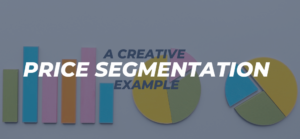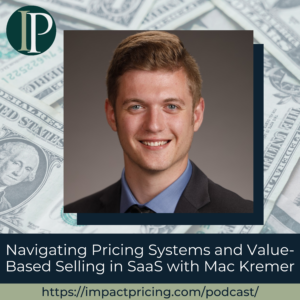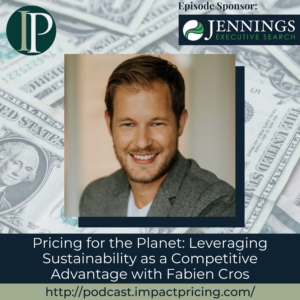Sebastian Baier is the founder of Buynomics, an AI for ultimate customer-centric RGM decisions- in one SaaS solution.
In this episode, Sebastian discusses how Buynomics’ AI utilizes vast amounts of consumer behavior data to generate virtual customers, enabling the implementation of optimal pricing strategies.
Podcast: Play in new window | Download
Why you have to check out today’s podcast:
- Learn how to create a customer simulation to identify the key factors that drive the value of a product and develop effective pricing strategies for optimal results
- Discover how to create a customer model for B2B, even when limited data is available
- Learn how to effectively analyze and interpret customer data in terms of distribution rather than segment
“Collect data however ugly it might look.”
– Sebastian Baier
Topics Covered:
01:12 – What got him into pricing
02:47 – Buynomics and what it does
04:41 – Understanding customer simulation and segmentation in the way Buynomics work
08:03 – Talking about segments and distribution densities
12:24 – How Buynomics helps provide what-if analyses for pricing strategies
13:29 – Creating customer models for B2B when there are not enough data available
17:28 – Sebastian’s thoughts on Mark’s suggested solution for B2C clients
19:11 – Salesperson as a value driver for B2B customer simulation
19:48 – Sebastian’s best pricing advice
Key Takeaways:
“Even if you don’t have great data [with B2B], you’ll use the data because you have to have a model of the world.” – Sebastian Baier
“To make statistics work, you have to have a certain number of customers.” – Sebastian Baier
“It’s really very valuable just to start collecting the data, and look at them as you would as a consultant.” – Sebastian Baier
Resources/People Mentioned:
- Slack: https://slack.com/
- Zoom: https://zoom.us/
- Vodafone: https://www.vodafone.com/
Connect with Sebastian Baier:
- LinkedIn: https://www.linkedin.com/in/sebastian-baier
- Email: [email protected]
Connect with Mark Stiving:
- LinkedIn: https://www.linkedin.com/in/stiving/
- Email: [email protected]
Full Interview Transcript
(Note: This transcript was created with an AI transcription service. Please forgive any transcription or grammatical errors. We probably sounded better in real life.)
Sebastian Baier
Collect data however ugly it might look.
[Intro]
Mark Stiving
Welcome to Impact Pricing, the podcast where we discuss pricing, value, and the complex relationship between them. I’m Mark Stiving and our guest today is Sebastian Baier. And here are three things you want to know about Sebastian before we start. Here’s the founder and managing director at Buynomics. We’re going to learn a little bit more about them in a few minutes. He did his obligatory five-year stint at Simon-Kucher & Partners, which says he knows something about pricing. He has a PhD in Physics, by the way, don’t all of us pricing people have PhDs in physics and he finished his first Ironman in less than 10 hours, like seconds. Less than 10 hours. Welcome, Sebastian.
Sebastian Baier
Hi, Mark. Great, thanks for having me.
Mark Stiving
Hey, it’s going to be fun. Okay, so how did you get into pricing?
Sebastian Baier
I think it’s more or less a coincidence. So I interviewed for some consultancies then I was doing my PhD because I wanted to get out of research basically. And, I just happened to like the people at Simon-Kutcher. So, I took the offer and since then I’m in pricing.
Mark Stiving
Okay. So here’s a better question. Why do you stay in pricing? You have a PhD in physics.
Sebastian Baier
Yeah. Actually I think there’s a huge discrepancy in pricing or in say, marketing between what you can really do, in my opinion with data, because I think it’s very data heavy and should be a very data-based discipline and what is actually done. I think a lot has changed due to tech because marketing with the dominance of those tech companies becomes more and more data focused. They are very open to it, but in our segments it’s still a lot of gut feeling, so very anecdotal, and I really love making data-driven decisions or putting people as a consultant or now with Buynomics in the position to make data treatment decisions. And therefore it’s not that far-fetched, I would say.
Mark Stiving
Okay, so I love that. Before I dig into data centricity with you for just a second, tell me what does Buynomics do? What does your company do?
Sebastian Baier
So we are building a SaaS platform that helps companies like Vodafone and others to make better pricing and revenue management decisions. And we do this in, I think, what I would say in a unique way. We take the data and transform them into something we call virtual customers or virtual shoppers, which of course is a marketing term, but you can think of it, we are creating millions, tens, or hundreds of millions of virtual personas, which reflect the behavior of real personas or real shoppers, pretty accurately. And basically, you can show them all kinds of changes to your portfolio, including pricing, of course, and they predict or they make a decision. And this decision is very close to real shoppers’ decision. And we found the concept. We actually loved the concept. We started the company based on, for us, it was like more of a scientific experiment when we started the company more scientific experiment than just actually a business. And, yeah, we just wanted to prove that this can be done because we’re so unhappy how customer reactions are done today to name price elasticity. I think everyone would ever price elasticities knows what I’m talking about.
Mark Stiving
Yeah. Okay, so I got to say that sounds fascinating. We’re going to do a statistical model or a mathematical model, and I assume that we’ve got multiple different market segments or maybe a distribution of different behaviors in our customer base, something like that. How do you decide which features, which customer characteristics belong in that customer simulation?
Sebastian Baier
I think, I mean for, let’s take an example, Coca-Cola, right? So some things are pretty obvious. So the main value drivers in the software market, so the main value drivers and what is the value driver? Value driver is what defines a product from a customer perspective or more precisely what distinguishes products from a customer perspective. So what distinguishes products from a customer perspective? And it stands in front of a shelf and says, I take that one and not that one. And this is most obvious in many segments, the brand, right? Is it Coke? Is it Pepsi? Is it a white label brand? Then of course you have a bottle size that’s also very obvious.
Then sometimes you have a pack size. Is it just one bottle? Is it a four pack, six pack, eight pack? Then you have sugar content. Is it a full sugar diet, zero sugar? So those are the main things typically. So those are the main tangible things. And then you can always test for things like recycled plastic, some environmental label, rich in minerals in many cases, organic and things like that, of course. And then there is also what we would call non-product defining attributes, something like a promotion, right? So this doesn’t obviously change the product itself, but it changes massively how customers perceive it. Is it on eye level? Is it on an aisle right before the checkout? Is it if it’s a digital good, is it highlighted on the website, et cetera.
And those things are relatively straightforward, but we are also flexible to take in our attributes if our clients tell us they consider them relevant, but the majority of weight typically comes from those relatively obvious value drivers. And one funny thing perhaps when we were back in citing there was a project with a vodka manufacturer, and they were, in all honesty, they said like the foot mats, where you put your feet on in the car, they distinguish their car from another car. And that’s what drives customer perception. I think a lot of manufacturers overestimate how complex customers see the world and what really drives that decision.
Mark Stiving
Yeah. So it seems to me that the product related items, they’re not changing. And so these are relatively easy to figure out. The promotion, the marketing, the things that are changing all the time. Those are the fun ones because those are the things we get to make decisions on, right? And so now we can influence purchase behavior, buyer behavior. And so should I make the guess that you’re creating an individual customer model that says, here’s a set of customers who value or who are influenced by where it is on the shelf, and yet they’re not influenced by price promotion, or they are influenced by, whether it was an ad in the newspaper this week? All right, so then there’s a whole bunch of different attributes that happen and we look at, we create individual characteristics of individual customers so that we can aggregate them all and say, hey, here’s what your market tends to look like.
Yep. I think that’s the way I would exactly have put it if I was back in consulting, because that’s like the way you typically think about customer segments, or those customers care more about brand, those customers care more about that. And that’s I would say that’s a very human way to think about those things. But in reality, there is no such thing as customer segments. There are only distribution densities, so everything follows distribution. So there’s no such thing that here people tend to care about brands and they care more about those. So you only have, you always have those people, you only have distributions of preferences. And this is, of course, complex because that means you don’t have to take free values into account over your population, but if your population is 10,000, you have to take 10,000 values into account.
But this is only a problem for humans, right? So we come out of the world where memory and computational power are limited, but this time is over, right? So memory and computational power are not limited, and algorithms can have not like five or 10 or 50 customer segments in their head, but 50 million, and this, you make a mistake, right? So you pay a price for limiting reality, which is the distribution into boxes that you can keep in your head. And in our discipline, which is pricing promotional products, it’s a very heavy price. It’s like if you’re a shoe manufacturer or short manufacturer, and there’s, you say there are three types of, people, or men, right? So five foot, seven, six foot, zero, and six foot three, that’s it, it’s not true, right? So we have a distribution, and so we have a distribution of human behavior. If you consider that we see it’s much more accurate in predicting how real populations behave.
Mark Stiving
Yeah, I think that makes a ton of sense in terms of making predictions. The thing that’s nice about segments, the way humans think about it is we can now make decisions about a segment where it’s much harder to make a decision about a distribution. So, I’ll use your example for a second. I’m building shirts and I want my shirts, I’m going to make three sizes, small, medium, and large. And so when you give me a distribution, it’s like, well, now I don’t know which size I really need to make, but when I say, hey, here’s what a small person looks like, I make a shirt for that person, and now we see who fits in it, who doesn’t fit in it.
Sebastian Baier
Yeah, I think the way to think about it’s, this is a way to break down complexity, to analyze it, and then based on this analysis, you make a decision. Now what Buynomics is doing is we make the analysis for you. You can slice and dice the data, which has all this massive complexity beneath in digestible ways, right? So we say, okay, so many people will go there and if you introduce a new brand here, you’ll lose. And so many people will go there and they cannibalize away from this. So we make this, of course, available on a higher level. So we don’t force our users to go through an Excel sheet with 1 million rows to understand each of the virtual customers. So this is taken from you, but we just provide transparency.
So at the lowest level you can think of our company as a transparency machine, right? So we give transparency, we don’t really care what you do with this transparency. You make the decisions, right? Based on what would happen if you like it or not, we say what happens in our opinion, and then you’ll need to make the decision. So basically we just give you the rules, you still have to play yourself. Of course, we have now on top features which tells you, look, given that, and that we would recommend doing this, and we would recommend given the market dynamics that you now change a promotion frequency or whatever. But this is already, I would say, a level above in terms of usability at a very core VR transparency machine.
Mark Stiving
Yes. And so you’re going to provide a bunch of what if analysis so that as I make an adjustment, I say, hey, I might want to do a promotion this week for this. And you’ll say, here’s what we think is going to happen
Sebastian Baier
Exactly, or you can just make the decision without looking at what we recommend at any analysis. And just then we say, okay, we think that would happen just like a price just much more complex because you have like all the interdependencies, et cetera. So you can operate on a very high level, not caring about a model about anything. Just go ahead and say, look, in Walmart, my six packs should be, have more of promotion depth and less frequency or whatever you wish. And you can say, okay, that’s it. And then we just tell you, okay, we think this is what happens to your sales and to your revenue, but you can also go much, much deeper down the rabbit hole. So we have this option, you can go all the way down, but you don’t have to.
Mark Stiving
Yeah. Okay, Sebastian, I have to tell you that I love this. This is just awesome. Now, I spend a bunch of my time in B2B where we don’t have as much data as these large B2C customers do. Is there a solution for that? Do you guys do something? Is it even possible to do something?
Sebastian Baier
Yeah. Now the most frequent and the most hated consultant answer, it depends, right? So yes the short answer is yes, but I mean, what we have, our opinion is a statistical model of customer behavior. So to make statistics work, you have to have a certain number of customers, right? So if you are producing cement and selling to the five biggest construction companies in the world, every deal is totally individualized. For example, in a B2C, like B2B, for example, Slack, right? So everything or Zoom, right? Everything there you go on the website, on the pricing page, and you have your good, better, best offer, whatever slice, and then you need to to determine, okay, there are my checkboxes, which one has the red frame around it and says, best value for money or customer choice.
And then you say,10, 20, 30 this week only for blah, blah, blah. And you have like hundreds of hosts of customers. This is possible because it’s the same kind of people who make the decision. If it’s a very tailored thing, it’s somewhat more elaborate. I think it still makes sense because in the end, you are not there. You have to focus, right? So in, we’re in FMCG, telco, and software at the moment. So we don’t do large cap B2B, but what I mean, one argument, I say a lot, but it’s not working very well in sales. I don’t know for what reason you will make a decision anyway, right? So, and even if you don’t have great data, you’ll use the data because you have to have a model of the world, right?
So you’ll make your decision based on a model of the world. And I would say the discrepancy between, for example, what we do or perhaps others who do a good job, I don’t know, but in the middle crowd, not zero data, but in the middle crowd between zero and perfect data, it’s the biggest uplift. Because on the other hand, if you don’t know you have Apple and they are pricing the new iPhone, the most important product in the world, they will do a perfect market study with tens of thousands of very well-selected panels of customers and make this one decision on how they change it. And they’ll not touch that for a very long time. We are not better there, right? If they feed the data into our solution, I would say we add no value, but this is not the case for basically all the realistic scenarios I have seen. So very typically you make changes continuously, you don’t have perfect data, you have to see your channels differently across, etcetera.
Mark Stiving
Yes. So I want to make up a solution for you and tell me if you like this, if this is feasible. So in your B2C world, let’s pretend that there are a hundred different consumer behaviors that you have modeled into a consumer. And so we say, let’s move that to B2B, and it may be slightly different behaviors, but there’s still a hundred different behaviors that we imagine a buyer is going to exhibit. And instead of saying here’s the priority of this behavior over that behavior, or here’s how someone prioritizes this. Instead of statistically determining it, we ask the customer, how would you rate these? How do you think your customers behave? What do you think the distribution would look like? And so then we’ve got that same exact prediction engine, the predictions didn’t come out well, of course not. And we go back to the customer and say, okay, what do you think we got wrong? If we tweak these things, we could have gotten that result. And so over time we could mentally tweak this model.
Sebastian Baier
It’s an excellent question, really. We did that at some point of view, and because like the beauty of what we do, like virtual customers, however you call it, but virtual customers, it’s a standardized model. And standardized model means you can feed it from different inputs and you can update it using established methods like patient updating, whatever. So you can feed it with transactional data and you can feed it with our data. So for example, telco, we do this very frequently that we take transactional data and market studies and combine them. And one input could be what you just said is expert judgment, right? You have and it’s actually in the roadmap, but at the moment, relatively low. We did it in the beginning because, like big product market fit.
I would say in the FMCG world, if I wouldn’t be pushed back from the product and engineering team I would do much more of those, more experimental things because I absolutely believe in it. We had it in the first version of the tool that I actually built in Excel with DBA myself, where we had had such a thing. But it’s totally fascinating. And then you can basically go along, right? So you can start, for example, with that, and while you can gather more and more transactional data, you can update a model more and more and then trust the transactional data more. So yeah, that’s definitely something here we’re considering. It’s really very impressive that you consider it on the fly.
Mark Stiving
It just seems to me that in B2B where we don’t have the data, we’d still like something like this to be able to help us think systematically through our customer decisions. Yeah.
Sebastian Baier
So, and you can do very, very interesting things about that, in B2B, for example, you can take the sales person as a value driver because that makes a big difference. How they perform basically, you can measure the sales person as a value driver and correct it automatically, basically through all the other factors of the deal. So that’s a ton of super interesting things you can do with B2B.
Mark Stiving
Yeah. Nice. Sebastian, we are running out time, but let me ask the final question for you. What is one piece of pricing advice you’d give our listeners that you think could have a big impact on their business?
Sebastian Baier
Collect data, however ugly it might look. I was always very much into data also in consulting. I love recreational data analysis, so I don’t have the tie for it, but I really like it. But now, since I’m basically in charge of the company, we collect much too little data, and in the beginning it doesn’t matter because you have fears you have at the top of your head, but then after some time, okay, well, it would be good if you collect that and why did you lose that deal and et cetera. So, it’s really very valuable just to start collecting the data and, and look at them as you would, as a consultant, because that’s the other thing. When it’s your old business, you are always tempted to really don’t look really cold at it, but you want to see the things and stuff. Look at it like a cold hearted consultant and that’s my one piece of advice.
Mark Stiving
I think that’s fabulous advice. I think all of us who run businesses have a really hard time looking at our own businesses, the way we look at other companies when we do it. So fascinating, Sebastian. Thank you so much for your time today. If anybody wants to contact you, how can they do that?
Sebastian Baier
I think the best way is LinkedIn. So on LinkedIn I also have my email address. I think I even have my phone number. So, yeah, LinkedIn, email, first name, last name at buynomics.com. Happy to talk.
Mark Stiving
Alright, and, Sebastian’s LinkedIn will be in the show notes as URL. To our listeners, thank you so much for your time. If you enjoyed this, would you please leave us a rating and a review, and if you have any questions or comments about the podcast or pricing in general, feel free to email me, [email protected]. Now, go make an impact!

















